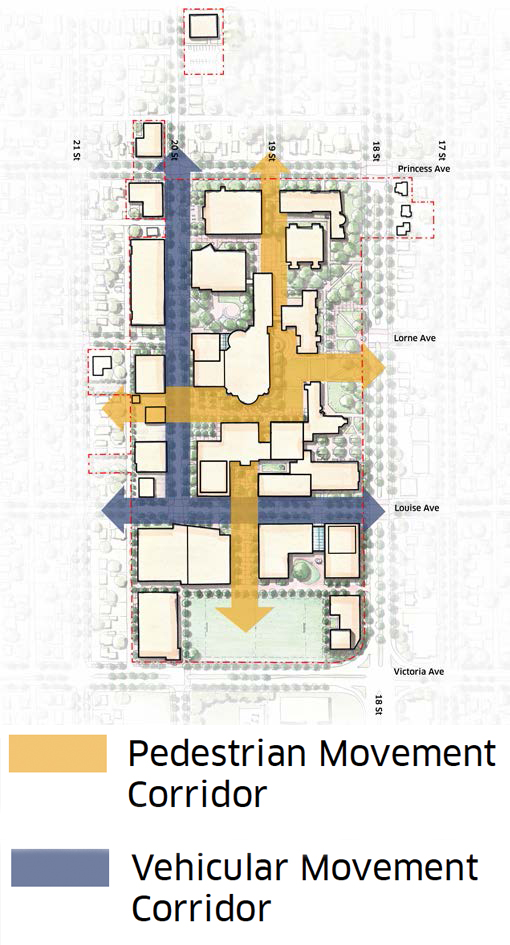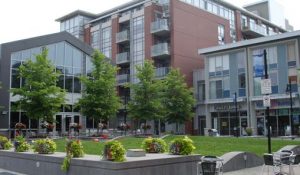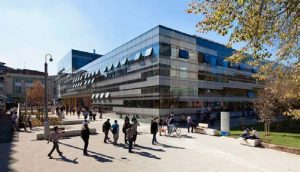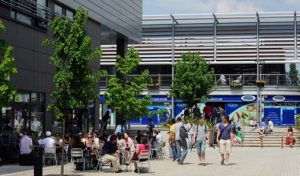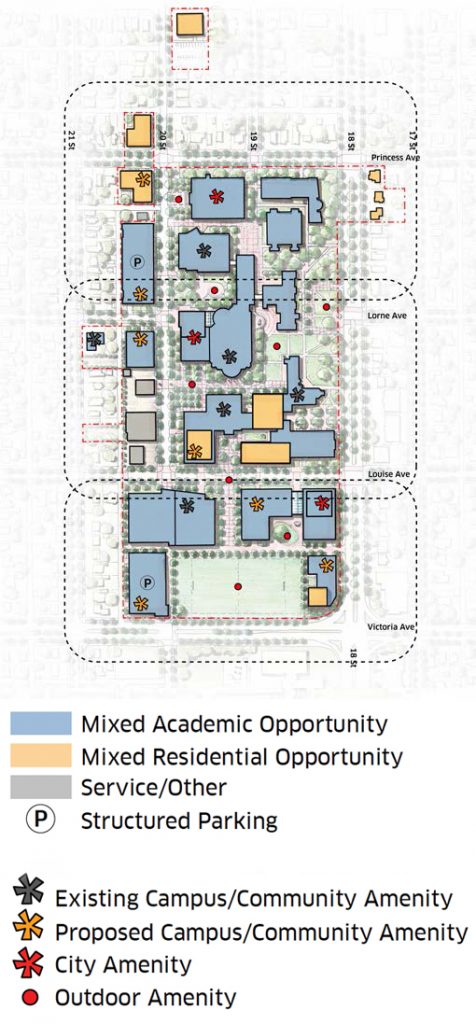Campus Structure
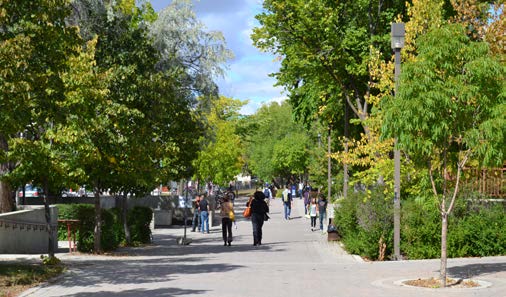
Through the orientation and placement of buildings, the maintenance of a compact campus and the development of distinct campus “hubs” for gathering this section defines the approach to built form for the Campus.
Orientation & Placement
The orientation and placement of buildings is essential to creating a friendly environment and is an integral part of wayfinding to and within the Campus. The physical structure of the Campus essentially follows the grid development pattern of the surrounding neighbourhood. It is defined by its two streets aligned north-south and east-west, and two primary pedestrian corridors also aligned north-south and east-west. These are the key structural elements that dictate the orientation and placement of buildings.
Most new buildings are hinged along the streets, as the adjacent lands present the best opportunities for development. The north-south pedestrian spine is a remnant structural axis of the heritage campus and is enhanced in the Plan with increased frontages and access onto the spine. The east-west pedestrian spine is located at the centre and heart of the Campus. New buildings are located along this spine and are oriented to engage and animate this movement corridor and pedestrian space.
Policies:
-
All new buildings must provide a frontage and multiple entrances onto the Campus’ streets and primary pedestrian movement corridors.
- All new buildings must provide a frontage and multiple entrances onto the Campus’ open spaces.
- Site corner gateway buildings (such as at Louise and Victoria Avenues) to first address the intersection of the street with a visible primary entrance, then address the primary street frontages, and thirdly the public spaces.
- Distinct architectural features and interventions such as enhanced architectural detail at building corners, are encouraged for buildings at gateway locations or fronting onto open spaces.
- Site buildings to allow for direct door connections to buildings that are adjacent or opposite to them.
Compact Campus Form
The Plan reflects a compact form of development for several key reasons: to create a campus environment that fosters walking as the primary mode of movement, which contributes to the health and well-being of the campus; to create a pedestrian oriented environment that is intimate and welcoming; to build an accessible University District nestled within the community that can provide services, amenities, education, and other uses all in one place; and as a respectful neighbour, to discourage the erosion of the adjacent neighbourhood fabric to the west. The University has the capacity to manage growth for the Campus, within its current boundary, for the time-frame of the Campus Master Plan, and should focus development energies inward on creating a great and welcoming place to be.
Policies:
- Create a compact campus that is walkable, allowing for seamless experiences of both the buildings and the open spaces.
- Concentrate development so that buildings are within less than a five minute walk on campus from end to end.
- Locate buildings so that there are short walking distances in between. This is especially relevant for a winter campus.
Mixed-Use Campus Form — Creating Distinct Campus Hubs
The Plan’s approach is to create a mixed-use context, creating distinct places or hubs of activity that are a mix of academic, residential, recreational, social, service and amenity, and community oriented uses. This mix of uses enables the animation of all areas of the campus and draws on the community from all sides. The following provides a recommendation for the general use and location of programs with the objective of creating distinct hubs of activity on campus. This structure is intended to be flexible, and used as a guide for placemaking.
A mixed-use structure provides opportunities to create distinct hubs of activity centred around social uses, amenities, and gathering spaces. The mix of uses are not only reflected as adjacencies to each other, but can also occur within a single building form, such as having academic uses at grade and residential or office uses above. All amenities accessible to the community should be located along the campus streets and main pedestrian passageways so that they are easily located and accessible. Campus-oriented amenity spaces (student focused spaces) can be located in areas internal to the Campus. Building on the existing structure and location of distinct uses such as the Centennial Auditorium to the north, the library in the centre of the campus, and the Healthy Living Centre in the south area, three distinct hubs can be developed accordingly, which collectively, provide a rich and unique campus environment.
North Campus Hub
The North Campus Hub can be built around the auditorium and the music building as the focus of activity, in addition to new uses that animate this area. Recommendations for the development of the North Campus Hub include the following:
- Locate student residences and hotelling residences as a complementary use adjacent to existing residential use and to diversify campus housing.
- Include amenities such as a daycare, or a “corner store” commercial use at grade to service the University community and surrounding neighbourhood.
- Enhance the Western Manitoba Centennial Auditorium building as a key local and city destination and centre of activity.
- Enhance the existing open spaces such as the plaza fronting the Queen Elizabeth II Music Building, the forest, the internal north spine, as useable, functional campus and community spaces that contribute to the animation of socialization of place.
- Provide a mixed-use parking facility with student, community, and Indigenous service and amenity space at the lower levels, and parking above.
- Enhance the existing music faculty’s student lounge space as a student destination for the northern campus hub.
- Enhance the existing buildings along the east side of 18th Avenue as opportunities for family style short term housing.
Central Campus Hub
The Central Campus Hub is focused around the activity generated by the library and Harvest Hall, which have already defined this area of the Campus as a distinct and recognizable place, as the campus heart. Recommendations for the development of the Central Campus Hub include the following:
- Enhance the existing library and Harvest Hall as the centre of student activity.
- Create a strong academic focus in the heart of the campus to include space for: classroom and faculty, office, business partnerships, and incubator with the student hub as the social centre.
- Enhance the existing east heritage forecourt plaza and the new quad spaces as destination spaces for University, community, and city events.
- Create a mixed-use building adjacent to the existing daycare facility with complementary academic uses such as continuing education or faculty office space, or family residences (including Indigenous specific residences) with community service and amenity space at grade.
- Create mixed nodes focused on the east-west plaza and on Louise Avenue to include residential, academic, office, and campus and community services and amenities.
- Enhance existing and create new open spaces to support the mixed use nodes.
South Campus “Health and Wellness” Hub
The Healthy Living Centre, which is a significant University and community asset, and the athletic field has already defined the south area of the campus as an emerging health and wellness hub and should be enhanced accordingly. Recommendations for the development of the South Campus Hub include the following:
- Enhance the south campus as a hub for health and wellness on the Campus with complementary academic uses adjacent to the Healthy Living Centre and athletic field.
- Locate student residences fronting the field to animate and provide “eyes on the field”, and to create a 24/7 presence for the south campus.
- Provide a mixed-use parking facility fronting Victoria Avenue with student and community service and amenity space at the lower levels, and parking above.
- Create a new amenity space as the southern student hub for the Campus with a visitor’s and information centre as a prominent gateway feature and use.
- Create a new city-wide destination to animate the south end of the Campus and build identity for the University, such as a gallery space for art, or a research and incubator show space.
- Enhance existing and create new open spaces to support south campus uses and to animate the southern area of the Campus.

